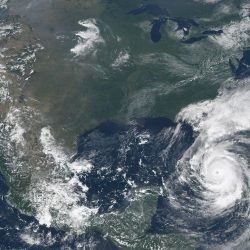Storm Surge
Sociologist tracks migration in the wake of Hurricane Katrina.
Hurricane Katrina changed the face of New Orleans — not just physically, as Elizabeth FussellPhD’98 discovered, but demographically, as well. At least in the short term, the storm caused the city to become less African-American and more Latino, as African-Americans living in hard-hit neighborhoods had greater difficulty returning home.
Fussell, a UW-trained sociologist, was on the faculty of Tulane University when the storm hit the Gulf Coast in August 2005. Like the vast majority of her fellow New Orleanians, she sought refuge farther inland — some 85 percent of the population of southeast Louisiana evacuated, and the storm and ensuing failure of the levy system flooded 80 percent of the city of New Orleans.
Over the following year, the city returned to about half of its pre-Katrina population. Roughly 450,000 people lived in New Orleans prior to the storm. By July 2006, the Census Bureau reported the city’s population to be 223,000, and it totaled 255,000 in March 2007.
“This was a rare event for a demographer to witness,” Fussell says. “You rarely see a city depopulate and then repopulate. It changed my research agenda.”
Previously, Fussell had focused on migration from Mexico to the United States, but after Katrina, she turned to studying her adopted hometown. She found that non-black New Orleanians — especially the more affluent — were among the first to return to their city, and that black residents were slower to come back. Further, the city saw a rise in its Latino population, due in part to the arrival of a group that Fussell calls “Hurricane Chasers.”
“They’re sort of a rapid-response labor force,” she says. “These were mostly young men, construction workers, and many were undocumented. Early on [during reconstruction], jobs were plentiful, and they moved in. They stayed as long as the construction boom was going on. But when jobs dried up, or more skilled labor was in demand, many moved on. However, some stayed. The Latino population has grown from 3 percent before Katrina to about 5 percent in 2010.”
The dynamics of the disaster-recovery economy complicated race and class issues within New Orleans, Fussell says. Many local construction firms were destroyed and workers were displaced by the hurricane, and some large construction firms that were contracted to rebuild recruited workers from outside the city and hired few local residents.
“There were a lot of construction workers, both black and white, who weren’t able to get work,” she says. “They thought they couldn’t get hired because employers preferred Latinos who took lower wages and weren’t unionized.”
Now based at Washington State University, Fussell has published several articles on the repopulation of New Orleans, and she’s currently turning her research into a book.
Published in the Winter 2011 issue



Comments
No comments posted yet.